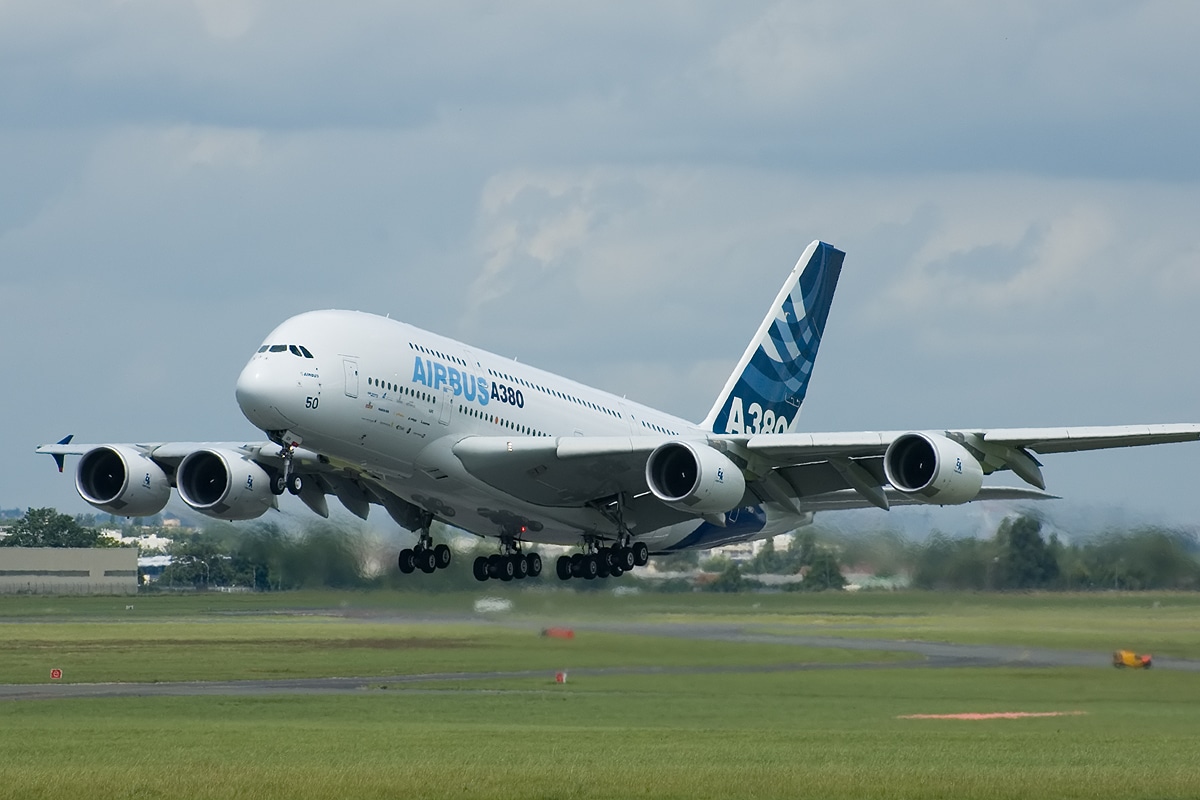Aerospace
10 things you must know about Airbus A-380

1. Easy on the Gas
It’s big, but not a gas-guzzler. Calculated per passenger, Lufthansa’s A380s get 69 miles per gallon. The airplane holds 81,890 gallons, meaning that more than a third of what the plane weighs on takeoff—560 tons—is the weight of the fuel.
2. Rolls-Royce Engines
The four Rolls-Royce engines of the A380 are the length of a Mercedes C-series sedan and four times as heavy. The internal temperature of the engine in operation is 3100 fahrenheit degrees.
3. Big Wings
The A380’s wings are the biggest ever created, 2,775 square feet in size and fully 54 percent larger than the wings of a Boeing 747.
4. Smooth Takeoff
During takeoff, the A380’s wings practically flap, as the tips flex upwards as much as 13 feet.
5. European Made
The A380 is a pan-European product. The engines and wings are produced in England, parts of the fuselage and the tail in Germany and Spain. Airbus test engineer Fernando Alonso describes the airplane as “a symbol of Europe.” When complete, these airplane sections are shipped by land, air, and sea for final assembly in France.
6. Exclusive Airports
Twenty airports in the world are handling A380 service, meaning that they have long enough runways, wide enough taxiways, and 78,000 square feet available at the boarding gate where the plane can be parked. Airports also need special equipment to handle passengers and cargo, and sometimes even baggage conveyor belts must be lengthened since 500 to 800 passengers means a lot of luggage.
7. More Computer than Machine
The A380 is flown by two pilots. “Actually, there’s no difference between flying 30 passengers and 526,” says Harald Tschira, a Lufthansa first officer. “This airplane is very easy to control, despite its weight, and the handling characteristics are more like a short-range airplane.” The pilots can nap in a sleeping compartment located behind the cockpit on long-haul flights while a second crew provides backup.
8. 21 Attendants
Twenty-one flight attendants are assigned to the Lufthansa A380, working in five galleys and using a separate computer system dedicated to cabin activities. They have their own rest compartment with eight beds located below the galley at the rear of the airplane.
9. Seat with a View
From individual video monitors at each seat, passengers can watch the progress of the flight from cameras mounted below the cabin and on the airplane’s tail.
10. Maximum Range
The A380-800 has a design range of 8,500 nautical miles (15,700 km), sufficient to fly nonstop from Dallas to Sydney, and a cruising speed of Mach 0.85 (about 900 km/h, 560 mph or 490 kn at cruising altitude).
Other important facts
The A380 is 15 tonnes lighter than it would be if made entirely of metal.
- The 4400m2 surface of the A380 is covered in three layers of paint weighing around 500kg.
- During take-off the A380 wing will flex upwards by over 4m.
- The air in the A380 cabin is changed every two minutes, and the temperature can be selected between 18 and 30 degrees.
- An A380 takes off or lands every three minutes
- 8000 bolts are used to attach the three main parts of the aircraft. In total an A380 comprises of 4 million individual components, produced by 1500 companies, in 30 different countries.
- The A380 is a low-noise aircraft and uses light-weight and environment-friendly components. This aircraft also has lowest emission than any other aircraft.
- The aircraft is designed for 140,000 flying hours.
- If all the wiring in the A380 is laid end to end, it will stretch from Edinburgh to London – 320 miles.
- More than 3600 liters of paint is required to paint the exterior of the aircraft.
- The giant plane flies at 43,000 feet, with maximum speed of 640 miles/hour.
- The A380 is 24.1 meters high, 80 meters wide, and 72.7 meters long, equivalent to 2 blue whales length. The plane weighs approximately 590 tons.
- The wings of the plane are 54% larger than the wings of a Boeing 747 aircraft.
- The giant plane has enough space to carry approximately 3000 suitcases and 525 passengers.
- The A380 holds 81900 gallons of fuel weighing 560 tons. It burns 17% less fuel than other large airplanes. It consumes 4 liter of fuel in 100km per passenger.
- Only few runways in the world are now fully capable of handling A380 aircrafts. Others are not long or wide enough or not technically equipped for A380.
- Airbus on the other hand has gone big, so big in fact that it produced the world’s largest passenger plane, the A380. The A380 has 478 square meters of usable cabin space, making it 40 percent larger than the next largest passenger plane, the Boeing 747
liked it ?
Share with your friends and families

Aerospace
India is set to build a central command for the Air Traffic Control system, called ISHAN

India’s air traffic growth has led to increased responsibilities for air traffic control. The Airports Authority of India (AAI) is considering centralizing air traffic control for aircraft, dividing the country into four regions. The goal is to consolidate India’s segmented airspace into a single entity to improve air traffic management (ATM) efficiency, safety, and smoothness.
Recently, the AAI invited expressions of interest to develop a detailed project report for the Indian Single Sky Harmonized Air Traffic Management (ISHAN) initiative in Nagpur. Under this plan, air traffic controllers in Nagpur would handle domestic flights flying above 25,000 feet, eliminating the need for coordination among controllers in different regions.
For domestic regional flights operating above 25,000 feet, control would shift to the central command in Nagpur. This consolidation aims to enhance airline operations, increase flight handling capacity, and reduce congestion and flight times for passengers.
Currently, the AAI provides ATM services over Indian airspace and adjoining oceanic areas, covering over 2.8 million square nautical miles. This airspace is divided into four flight information regions (FIRs) in Delhi, Mumbai, Kolkata, and Chennai, along with a sub-FIR in Guwahati.
FIRs are responsible for providing air traffic services, including weather information, visibility, and search and rescue assistance. The proposed unification under the ISHAN initiative aligns with the projected growth of the aviation industry, which anticipates a doubling of domestic passenger traffic by 2030.
Aerospace
Does AirAsia show interest in Comac aircraft in the future?

Tony Fernandes, CEO of Capital A, operating as AirAsia Group, recently paid a visit to the facilities of COMAC on April 2, 2024, and was thoroughly impressed by what he witnessed.
C919 already securing nearly 1000 orders
COMAC, known for its homegrown aircraft, has launched two promising jets: the ARJ21 and the C919 aircraft. Both aircraft are gaining popularity in the Chinese market, with the C919 already securing nearly 1000 orders from various airlines.
Fernandes expressed his admiration for COMAC’s achievements in aircraft manufacturing, acknowledging the immense challenge it entails. His visit underscored the realization that AirAsia now has a viable third option when it comes to selecting aircraft for its fleet.
During his tour, Fernandes was delighted by the innovation and technology evident in COMAC’s aircraft production and the company’s commitment to long-term partnerships.
He noted that many Western companies have shifted away from prioritizing loyalty and customer service, opting instead for short-term gains and a narrow definition of success.
Last month, COMAC embarked on an international tour, showcasing demonstration flights to neighboring countries, particularly Indonesia and Malaysia. Fernandes believes that the positive impression left by COMAC during his visit opens up new opportunities for collaboration.
Fernandes emphasized COMAC’s remarkable achievements
The shared values of loyalty, customer service, and long-term vision align closely with AirAsia’s ethos, making collaboration with COMAC appealing. With a focus on innovation and excellence, both companies stand to benefit from a partnership grounded in trust and a shared commitment to success.
Indonesia and China have already collaborated in validating and maintaining the airworthiness of the ARJ21 aircraft, indicating a solid foundation for future partnerships.
In his statement, Fernandes emphasized COMAC’s remarkable achievements and genuine desire for long-term partnership, highlighting the absence of ego and a genuine willingness to succeed together. He marveled at COMAC’s fully automated, AI-driven factory, a testament to their dedication to innovation and efficiency.
Fernandes criticized Western firms for prioritizing short-term gains over loyalty, customer service, and long-term strategy, emphasizing the importance of understanding customers’ needs and collaborating to achieve success.
Aerospace
Indigo will soon launch Air Taxi Service in India

InterGlobe Enterprises, the parent brand of IndiGo, is set to revolutionize travel in India with its upcoming air taxi service.
Scheduled for a potential launch in 2026, this innovative venture promises a seamless journey for passengers between two bustling hubs. Delhi and Gurgaon in Haryana. The forthcoming service is projected to revolutionize the daily commute, offering passengers a swift aerial journey covering the distance in a mere 7 minutes.
This remarkable efficiency contrasts starkly with the conventional 90-minute drive, underscoring the immense time-saving potential for commuters. The anticipated fare, ranging from Rs 2,000-3,000, makes this innovative mode of transport not only swift but also remarkably competitive in pricing.
At the heart of this ambitious endeavor lies a strategic partnership with Archer Aviation, a pioneer in electric vertical takeoff and landing (eVTOL) aircraft technology. Under this collaboration, Archer will supply 200 state-of-the-art eVTOL aircraft, representing an investment of US$ 1 billion. These cutting-edge aircraft, capable of accommodating up to four passengers alongside the pilot, epitomize the future of sustainable air travel.
Powered by six battery packs, Archer’s eVTOL aircraft boast rapid charging capabilities, enabling a swift turnaround between flights. With a charging time of just 30-40 minutes, these eco-friendly aircraft ensure minimal downtime, maximizing operational efficiency.
Similar services are anticipated to be introduced by the joint venture in Bengaluru and Mumbai as well. Nevertheless, the service rollout period has not yet been made public by the company. Next year, it is anticipated to get its certification. Following this, the company will start the certification procedure with the Directorate General of Civil Aviation (DGCA).























